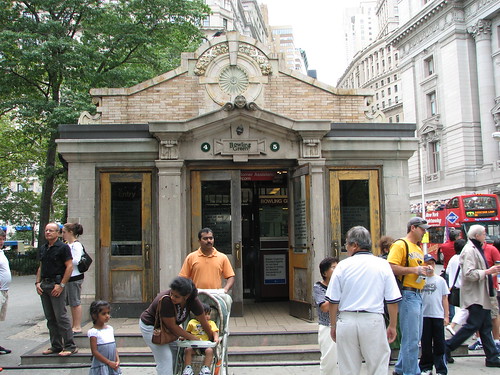Those urban denizens who rely on mass transit for their daily commute are often heard grumbling over how slow or crowded or expensive their train ride is. In light of the recent train wreck in Buenos Aires 1 (which was both gory and preventable), we would like to take a moment to reflect on the history of NYC's mass transit system.

Postcard of Elevated Railroad "Cooper Institute", early 1900s of NYC's East Village 3
In the 1800s, the importance of rapid transit to urban growth and efficiency became evident. Elevated lines were already in effect in cities such as New York, Chicago and London but a discreet underground system that did not rely on steam power would be more ideal. Though it was technically possible to build a steam operated subway system, construction of an subterranean
transportation system did not begin until 1901, when electricity could be used.
A.P. Robinson's
Plans for Subway (dated 1864), a steam-based prototype for our current system. 2
Our current system began as a privately owned company. In 1904, the the Interborough Rapid Transit Company (IRT) opened a 9.1 mile long subway line consisting on 28 stations (City Hall to 145th St) and within a few years opened lines to the Bronx and Queens, while the Brooklyn Rapid Transit Company (BMT) began service to Brooklyn in 1915. 4
Bowling Green IRT Control House, an iron and glass subway entrance/control house by architects Heins & LaFarge, New York City circa 1905. Photo taken 2007 5
New Kawasaki train undergoing testing September 22, 2005 in the 145th Street A, C, B, D station.
Over the last decade, the New York Transit Authority has made it a priority to upgrade its trains. Modernization and artful adaptive reuse is important to a changing society; it keeps straphangers moving and inspired. Consider the High Line for example, which has become a local source of pride and cultural tourism.
Having fallen into disuse, the city took ownership elevated freight rail line
running up the west side of Manhattan along 10th Avenue. Friends of the
High Line was founded in 1999 to preserve the public space, and
campaigned to transform it through an open competition. In 2011, the
second section, designed by Diller Scoffidio + Refro and James Corner
Field Operation, opened to the public. 7

New York City High Line Park, photo by Jill Fehrenbacher, June 9, 2009 6
1 "Argentina Train Crash in Buenos Aires 'Kills At Least 49', Leaves Hundreds Injured
2 "Fifty Years of Rapid Transit" by James Blaine Walker, Chapter 3, Pioneer Plans for a Subway. www.nycsubway.org
3 "Turn of the Century Cooper Square", posted November 12, 2009 on http://ephemeralnewyork.wordpress.com
4 "New York City Transit - History and Chronology". http://www.mta.info
5 "Battery Park Control House" by Michael, blogpost August 23, 2007 on The Masterpiece Next Door: All 500-Plus Manhattan Landmarks on the National Register of Historic Places, Blogged.
6 "New York's High Line Park in the Sky Opens Today" by Jill Fehrenbacher, blogpost June 9, 2009 on Inhabitat: Design Will Save the World. http://inhabitat.com
7 "ABOUT: High Line History" on High Line: The official web site of the High Line and Friends of the High Line. www.thehighline.org













